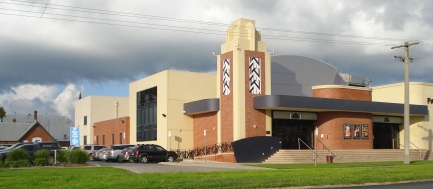CATHS PAST ACTIVITIES
RIVERINA -
Eighteen theatres, functional and closed, were the agenda for a five day tour on which CATHS's multi skilled Secretary, Mike Trickett was organiser, tour leader and ' Coach Captain' transporting 18 members more than 1500 km. Vice President, Peter Wolfenden was navigator and Brian Miller acted as scribe.
DAY 1:WEDNESDAY 9 OCTOBER
DAY 2: THURSDAY 10 OCTOBER
DAY 3: FRIDAY 11 OCTOBER
DAY 4: SATURDAY 12 OCTOBER
DAY 5: SUNDAY 13 OCTOBER
An access corridor along the left hand side of the former stalls area leads to a second cinema built at right angles across the old stalls. Cinema 2, which seats 96 opened at Easter 1999. The owner is exploring the option of opening a third auditorium in the former front stalls. The old stage area would again contain a screen and facilities for small live shows.
This report is necessarily brief. It cannot convey the sense of fun that is so much a part of a CATHS tour.
Compiled by Gerry Kennedy from reporting by Brian Miller and others
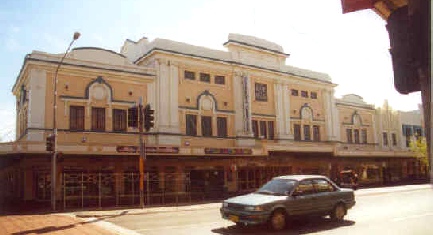
The Albury Cinema Centre at 546 Dean St, Albury (NSW) was a trip highlight. This six-
Most of the projectors are Cinemeccanica, with a Bauer in Cinema 2 (240 seats). Cinemas 3 -
In Wagga Wagga (population 43,000) the group visited the City Council's Civic Theatre. This attractive building faces the Murrumbidgee River. The Civic, built in 1962, is of brick, concrete and colourbond construction and features a refurbished (in 2000) stadium style auditorium. It is a multi purpose performing arts venue.
The Forum Six Cinemas, in Wagga Wagga opened in 1996, it is operated by Box Office Promotions, which also own cinemas in Orange and Tamworth (NSW). A feature of the complex is the large columned portico entrance, at the rear of a car park. The sizes of the stadium style interior are: 300 seats (2 cinemas), 188 seats (2 cinemas) and 156 seats (2 cinemas). All cinemas are equipped with Simplex projectors with digital surround sound.
Art Deco was the inspiration for the new Paramount Centre at Echuca (population 10,000). In this four screen venue Cinema 1 seats 393, Cinema 2 seats 140 and cinemas 3 and 4 each seat 102. Cinema 1 doubles as a well equipped performing arts space with spacious stage and backstage areas. The project is a partnership between the City Council and private enterprise. The Paramount Centre was featured in the CATHS magazine, CinemaRecord No. 36.
At Swan Hill (population 10,000) the former Regent Theatre (another of the O'Halloran Theatres) is substantially changed but continues to screen films. Also a design by Cowper, Murphy & Associates, this 990-
The Regent was converted into a smaller theatre c.1970. This space was then twinned and renamed the Oasis Cinema. The Oasis seats 150 and 170. Cinemeccanica projectors are used with platter systems for film transport. Part of The Swan Hill Town Hall is a magnificent example of Art Deco design currently being converted into a world standard performing arts centre.
From the day it opened in 1935 the Town Hall operated as a cinema, five days per week. Another of the O'Halloran Theatres, it traded as The Regent and then as The Civic after the new Regent was constructed. It seated 1080 and the projection room was under the rake of the circle. This building was reminiscent of a large suburban Melbourne cinema of the thirties. In Wycheproof (population 960) the Art Deco Town Hall was built in 1938. The architects were Leith and Bartlett. An attractive feature was the curved staircase to the upstairs foyer. Films have not been shown on a regular basis since c.1977, when it traded as the Broadway Theatre.
The final venue for the day was the Rex Theatre at Charlton (population 1400), which is run by two CATHS members. Built in 1938 this attractive theatre was featured in CinemaRecord No 14. The Rex originally seated 616 on two levels. Two staircases lead from the foyer directly into the front row of the balcony. The projection room was enlarged to accommodate two Phillips 35/70 mm projectors installed by the previous owners. These large machines came from Hoyts Esquire Bourke Street and Hoyts Altona Drive In. Our hosts provided the tour party with a great night of film entertainment and refreshments.
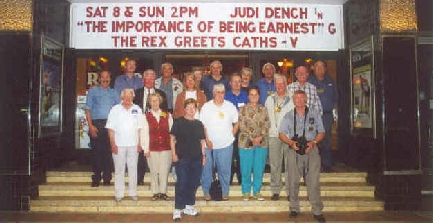
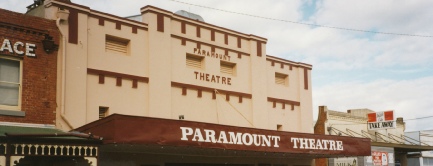
The Paramount Theatre, at 50 Nolan Street Maryborough (population 7800) was built in 1927 but due to construction problems the opening was delayed until 1929. This brick building has a cement rendered façade painted in buff with brown trims. The entrance lobby features attractive floor tiles. A central staircase leads directly to the cross aisle of the circle. The theatre seated 1123 patrons. The original projection room was on the ground floor; a large space that extended into the auditorium and included several ante rooms. The former Kalee 2 projectors with their Westrex arc lamps are still in situ. The auditorium had a sloped floor and a small stage area. The spartan decor of the auditorium was relieved by four square plaster murals now in storage for future use.
The Paramount was operated by the Wills family for many years and later Maryborough Theatres Pty Ltd. The Maryborough Town Hall (seating 600) was operated in association with The Paramount until the sixties. The theatre was later purchased by the local High School and used for concerts and as a basketball arena.
The current exhibitor, John Medlin re-
First port of call was Chiltern (population 1,200), and the first theatre to be visited was The Star Theatre, built 1867 as part of Star Hotel and used for live performances, it is a very early venue. In its cinema form, films were projected from a bio box built on the outside wall of the stage to a screen mounted on the rear wall of the auditorium! The building is single level, brick construction. The former portholes can be still be seen in the rear stage wall. Today The Star runs nostalgia screenings using a 16 mm projector. About 100 old style, tip up timber seats are used. One screen size, Academy ratio, is used. Red and gold stage curtains have been installed.
Next it was to the 16 seat home cinema of Bob and Margaret Adkins, also in Chiltern. Their set-
The nearby Bandiana Army Camp Cinema was our next stop. Most forces camps have modern, well-
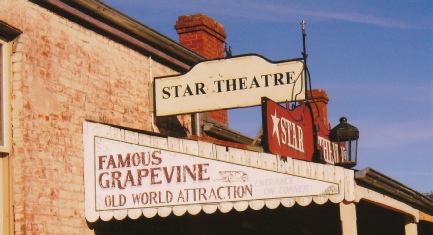
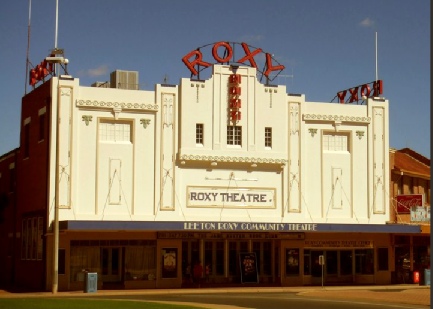
A short journey west brought the group to Leeton (population 6600) where the famous Roxy Theatre dominates the roundabout in the main street.
Opened in 1930 this substantial brick building is a two level theatre with direct access to the circle from a small main foyer. The auditorium is a typical twenties design -
In Narrandera (population 4,700) the former Globe/Plaza Theatre is home to the Christian Revival Church. The theatre opened as The Globe in 1927, was later damaged by fire and reopened as the Plaza in 1934, seating 1032. (The hall next door was used as a cinema whilst the Globe was rebuilt.)
An unusual feature of The Plaza was a double storied veranda, which gave the exterior the look of a country hotel. Access to the veranda was directly from the rear of the circle. Twin staircases to the circle led from the common entry to the stalls.
The church is built in the stalls area of the theatre. False walls and ceiling create a more intimate and appropriate space for worship. The former 1950's proscenium and CinemaScope screen are still in place and the circle is complete with its seats. There is no equipment left in the projection room.
Two venues were inspected in Deniliquin (population 7800). The Deniliquin Town Hall was a refurbished 19th Century ornate building with a flat floor and a small, high set balcony. Leased for years to O'Halloran Theatres, it ran as the Regent (seating 600) until they built their own Regent Theatre in 1957.
The second Regent was designed by the prolific firm of architects Cowper, Murphy and Associates. Smart design was evident in a two level venue with large ground floor foyers and a Crying Room. The theatre seated 801. The original Kalee 21 projectors were in use until the theatre closed about a year ago.
